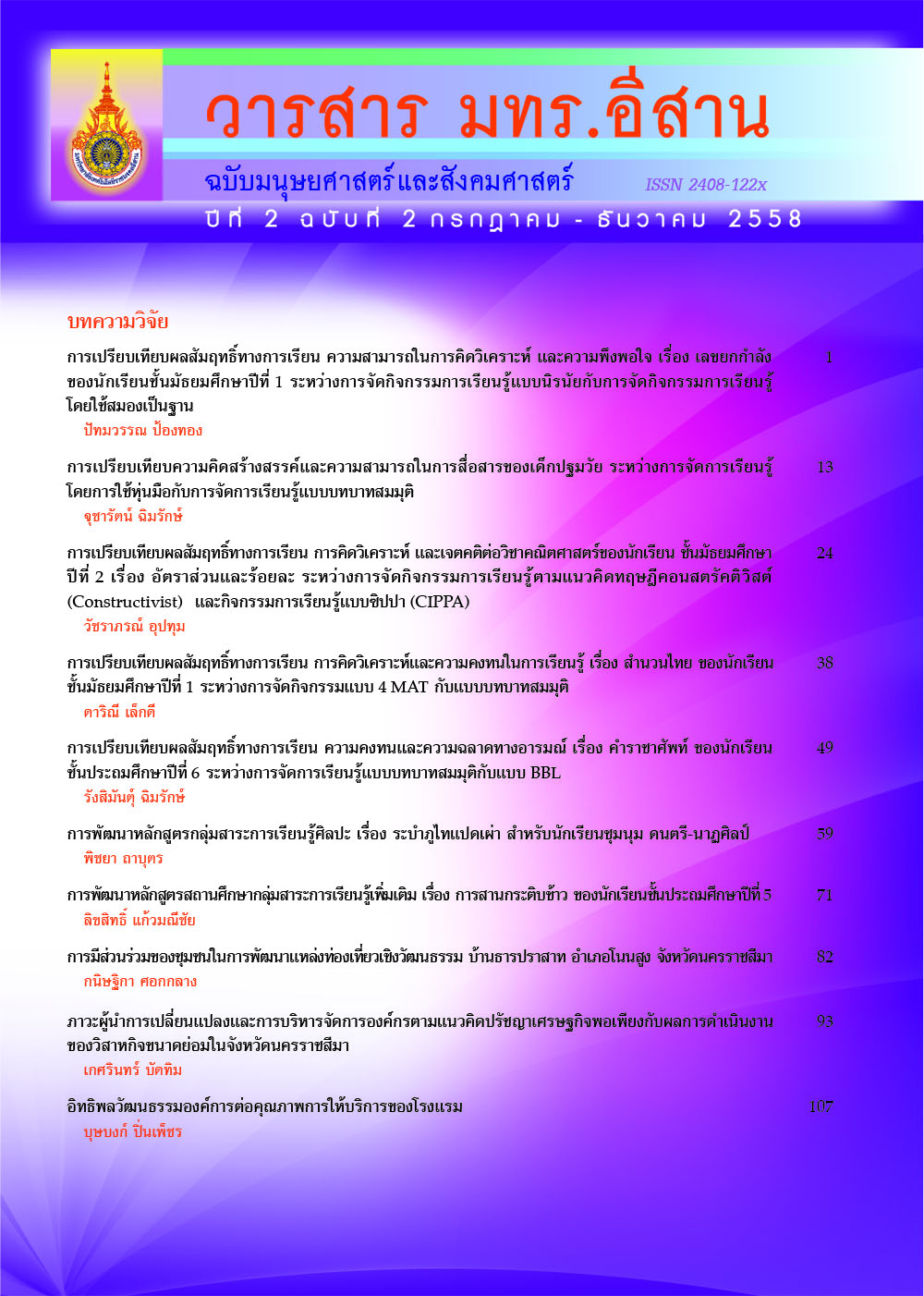การเปรียบเทียบความคิดสร้างสรรค์และความสามารถในการสื่อสารของเด็กปฐมวัย ระหว่างการจัดการเรียนรู้โดยการใช้หุ่นมือกับการจัดการเรียนรู้แบบบทบาทสมมุติ
Main Article Content
บทคัดย่อ
การวิจัยครั้งนี้มีวัตถุประสงค์ 1) เพื่อหาประสิทธิภาพของการจัดประสบการณ์ โดยใช้หุ่นมือและแผนการจัดประสบการณ์แบบบทบาทสมมุติซองเด็กปฐมวัยชั้นอนุบาลปีที่ 2 ที่มีประสิทธิภาพตามเกณฑ์ 80/80 2) เพื่อหาค่าดัชนีประสิทธิผลของแผนการจัดประสบการณ์โดยใช้หุ่นมือและแผนการจัดประสบการณ์แบบบทบาทสมมุติ ของเด็กปฐมวัยชั้นอนุบาลปีที่ 2 3) เพื่อเปรียบเทียบความคิดสร้างสรรค์และความสามารถในการสื่อสารของเด็กปฐมวัยชั้นอนุบาลปีที่ 2 ด้วยการจัดการเรียนรู้โดยไข้หุ่นมือและการจัดการเรียนรู้แบบบทบาทสมมุติระหว่างคะแนนก่อนและหลังเรียน 4) เพื่อเปรียบเทียบความคิดสร้างสรรค์และความสามารถในการสื่อสาร ของเด็กปฐมวัยชั้นอนุบาลปีที่ 2 ที่ได้รับการจัดการเรียนรู้โดยใช้หุ่นมือและการจัดการเรียนรู้โดยใช้บทบาทสมมุติ กลุ่มตัวอย่างที่ใช้ในการวิจัย ได้แก่ นักเรียนชั้นอนุบาลปีที่ 2 โรงเรียนบ้านรามราช สำนักงานเขตพื้นที่การศึกษาประถมศึกษานครพนม เขต 2 จำนวน 40 คน จำนวน 2 ห้อง ได้มาโดยการเลือกแบบเจาะจง เครื่องมือที่ใช้ในการวิจัย มี 3 ชนิด ประกอบด้วยแผนการจัดประสบการณ์โดยใช้หุ่นมือและแผนการจัดประสบการณ์แบบบทบาทสมมุติ จำนวนอย่างละ 20 แผน แบบรายสัปดาห์ แบบทดสอบความคิดสร้างสรรค์โดยอาศัยรูปแบบของ Torrance (Torrance Test of Creative Think Figural Form A) ซึ่งมีค่าความยากตั้งแต่ 0.42 ถึง 0.85 ค่าอำนาจจำแนก ตั้งแต่ 0.38 ถึง 0.60 และมีค่าความเชื่อมั่นทั้งฉบับเท่ากับ 0.94 แบบประเมินความสามารถในการสื่อสารเด็กอายุ 3-5 ปี ของกรมสุขภาพจิต กระทรวงสาธารณสุข จำนวน 55 ข้อ ซึ่งมีค่าความยาก ตั้งแต่ 0.54 ถึง 0.70 ค่าอำนาจจำแนกตั้งแต่ 0.35 ถึง 0.59 มีค่าความเชื่อมั่นทั้งฉบับเท่ากับ 0.97 สถิติที่ใช้ในการวิเคราะห์ข้อมูล คือ ร้อยละ ค่าเฉลี่ย ส่วนเบี่ยงเบนมาตรฐาน และการทดสอบสมมุติฐานโดยใช้ t-test (Independent Samples) และสำหรับการวิเคราะห์ความแปรปรวนร่วม (One-Way ANCOVA) และ E1/E2 ใช้วิเคราะห์ประสิทธิภาพ และ (E.I.) ใช้วิเคราะห์ดัชนีประสิทธิผล
ผลการวิจัยพบว่า
- ประสิทธิภาพของการจัดการเรียนรู้โดยใช้หุ่นมือด้านความคิดสร้างสรรค์มีค่าเท่ากับ 86.58/85.44 และด้านความสามารถในการสื่อสารมีค่าเท่ากับ 93.5/92.57 และประสิทธิภาพของการจัดการเรียนรู้แบบบทบาทสมมุติด้านความคิดสร้างสรรค์มีค่าเท่ากับ 93.47/89.89 และด้านความสามารถในการสื่อสารมีค่าเท่ากับ 93.36/92.27 ซึ่งสูงกว่าเกณฑ์ที่กำหนดไว้ทั้งสองวิธี
- ค่าดัชนีประสิทธิผลของการจัดการเรียนรู้โดยใช้หุ่นมือ และการจัดการเรียนรู้แบบบทบาทสมมุติด้านความคิดสร้างสรรค์มีค่าเท่ากับ 0.5904 และ 0.6860 และด้านความสามารถในการสื่อสารมีค่าเท่ากับ0.7805 และ 0.7648 แสดงว่านักเรียนมีความก้าวหน้าในด้านความคิดสร้างสรรค์คิดเป็นร้อยละ 59.04 และ 68.60 และนักเรียนมีความก้าวหน้าในด้านความสามารถในการสื่อสารคิดเป็นร้อยละ 78.05 และ 76.48
- นักเรียนชั้นอนุบาลปีที่ 2 ที่ได้รับการจัดการเรียนรู้โดยใช้ทุ่นมือและนักเรียนที่ได้รับการจัดการเรียนรู้แบบบทบาทสมมุติ มีคะแนนความคิดสร้างสรรค์และความสามารถในการสื่อสารหลังเรียนสูงกว่าก่อนเรียนอย่างมีนัยสำคัญทางสถิติที่ระดับ 0.01
- นักเรียนชั้นอนุบาลปีที่ 2 ที่ได้รับการจัดการเรียนรู้โดยใช้หุ่นมือกับแผนการจัดประสบการณ์แบบบทบาทสมมุติ มีความคิดสร้างสรรค์แตกต่างกันอย่างมีนัยสำคัญทางสถิติที่ระดับ 0.01 และนักเรียนชั้นอนุบาลปีที่ 2 ที่ได้รับการจัดการเรียนรู้โดยใช้หุ่นมือกับการจัดการเรียนรู้แบบบทบาทสมมุติมีความสามารถในการสื่อสารไม่แตกต่างกัน
Article Details
บทความที่ได้รับการตีพิมพ์เป็นลิขสิทธิ์ของมหาวิทยาลัยเทคโนโลยีราชมงคลอีสาน
ข้อความที่ปรากฏในบทความแต่ละเรื่องในวารสารวิชาการเล่มนี้เป็นความคิดเห็นส่วนตัวของผู้เขียนแต่ละท่านไม่เกี่ยวข้องกับมหาวิทยาลัยเทคโนโลยีราชมงคลอีสานและคณาจารย์ท่านอื่นๆในมหาวิทยาลัยฯ แต่อย่างใด ความรับผิดชอบองค์ประกอบทั้งหมดของบทความแต่ละเรื่องเป็นของผู้เขียนแต่ละท่าน หากมีความผิดพลาดใดๆ ผู้เขียนแต่ละท่านจะรับผิดชอบบทความของตนเองแต่ผู้เดียว
เอกสารอ้างอิง
เกรียงศักดิ์ เจริญวงศ์ศักดิ์. (2550). การคิดเชิงสร้างสรรค์. พิมพ์ครั้งที่ 5. กรุงเทพฯ : ชัคเซส มีเดีย
จิราภรณ์ ส่องแสง. (2550). การเปรียบเทียบความคิดสร้างสรรค์ของเด็กปฐมวัยระหว่างการจัดกิจกรรมศิลปะบูรณาการ. มหาวิทยาลัยมหาสารคาม : วิทยานิพนธ์ กศ.ม.
ทัศนีย์ ดีเลิศ. (2551). การเปรียบเทียบความคิดสร้างสรรค์ในกิจกรรมศิลปะของเด็กปฐมวัยระหว่างการจัดการเรียนรู้ทีสอดคล้องกับการทำงานของสมองโดยใช้รูปแบบไตรสิกขากับการจัดการเรียนรู้รูปแบบกิจกรรมศิลปะสร้างสรรค์วิทยานิพนธ์ กศ.ม. มหาวิทยาลัยมหาสารคาม
พัชรี กัลยา. (2551). การเปรียบเทียบความสามารถในการคิดเชิงเหตุผลของเด็กปฐมวัยด้วยการจัดกิจกรรมโดยใช้หุ่นการศึกษาค้นคว้าอิสระ กศ.ม. มหาวิทยาลัยมหาสารคาม
ลักคะณา เสโนฤทธิ์. (2551). การจัดประสบการณ์เพื่อพัฒนาความคิดสร้างสรรค์ของเด็กปฐมวัยระหว่างการจัดกิจกรรมเกมการศึกษา. การศึกษาค้นคว้าอิสระ กศ.ม. มหาวิทยาลัยมหาสารคาม
ลักษณา แก้วทอง. (2550). การจัดประสบการณ์เพื่อพัฒนาความคิดสร้างสรรค์ด้วยเกมการศึกษาของเด็กชั้นอนุบาลปีที่ 2. การศึกษาค้นคว้าอิสระ กศ.ม. มหาวิทยาลัยมหาสารคาม
วนิช สุรารัตน์. (2550). ความคิดและความคิดสร้างสรรค์. กรุงเทพฯ : สุวีริยาสาส์น
สมศักดิ์ ภู่วิภาดาวรรธน. (2549). เทคนิคการส่งเสริมความคิดสร้างสรรค์ (พิมพ์ครั้งที่ 6). กรุงเทพฯ : ไทยวัฒนาพานิช จำกัด
อารี สัณหฉวี. (2550). กฤษฎีการเรียนรู้ซองสมองสำหรับพ่อเเม่ครูเเละผู้บริหาร. กรุงเทพฯ: เบรน- เบส บุ๊ค. สำนักงานคณะกรรมการการศึกษาขั้นพื้นฐาน. (2548). คู่มือหลักสูตรการศึกษาปฐมวัยพุทธศักราช 2546 (อายุ 3 - 6 ปี). กรุงเทพฯ : กระทรวงศึกษาธิการ


